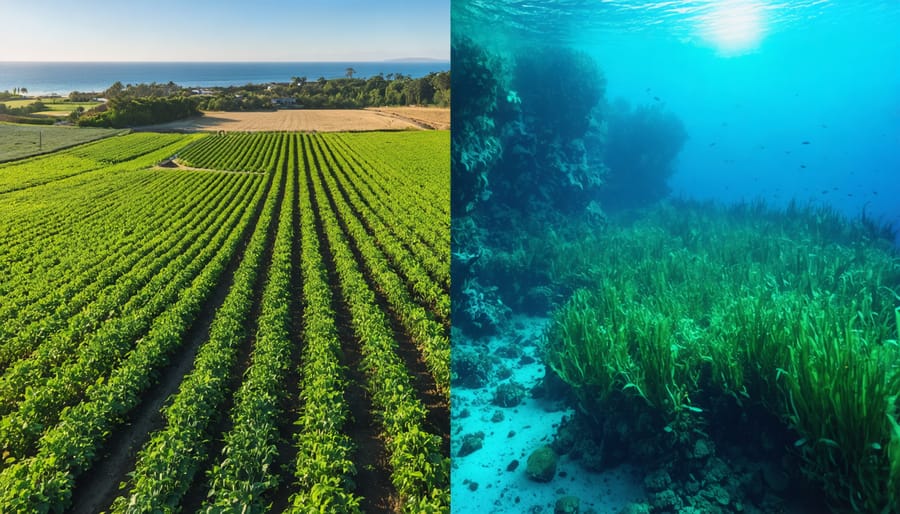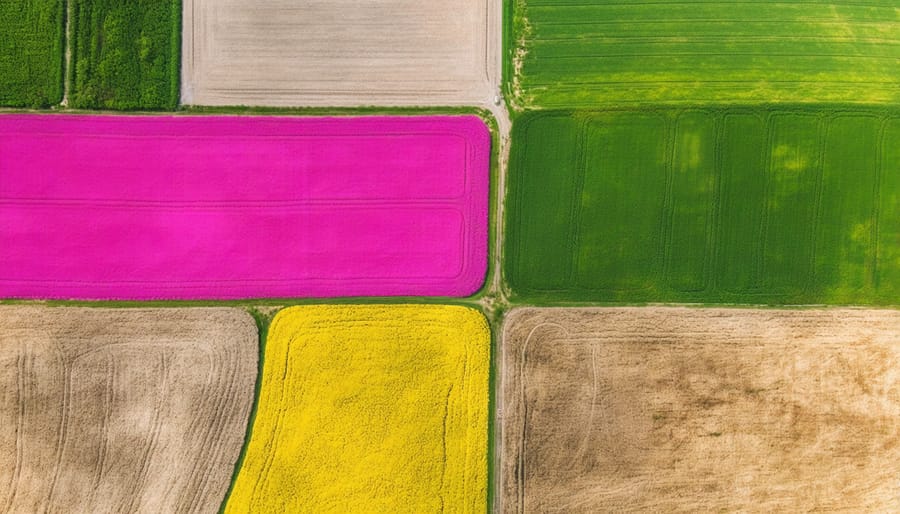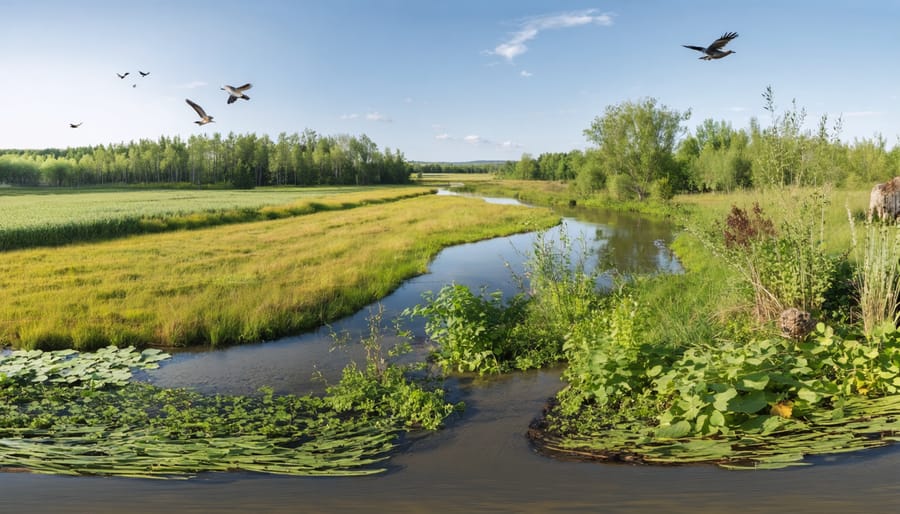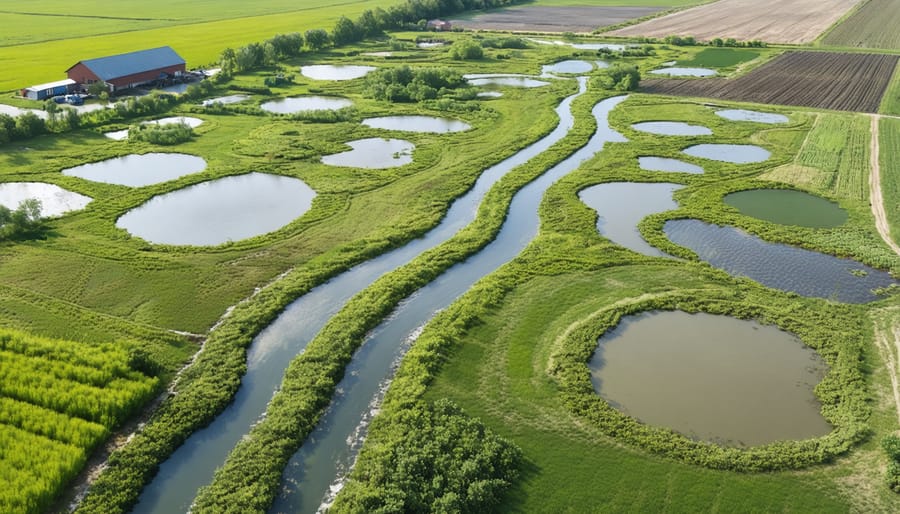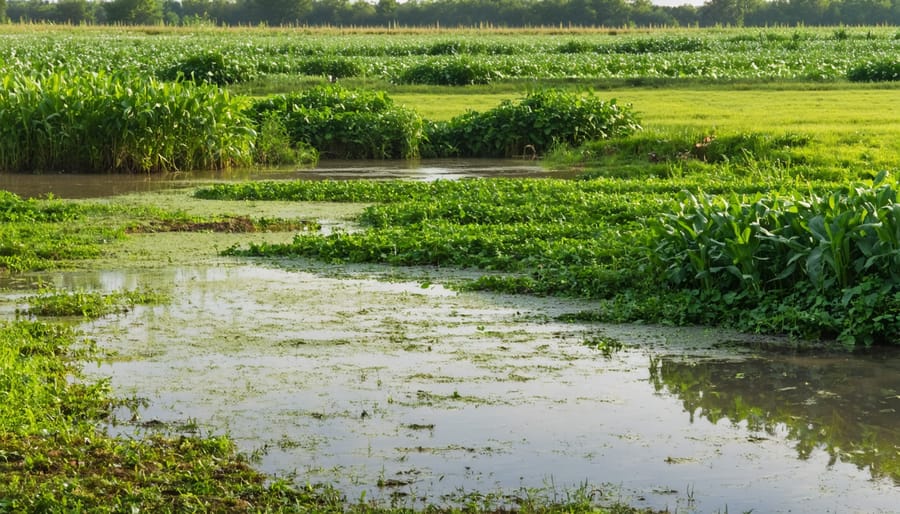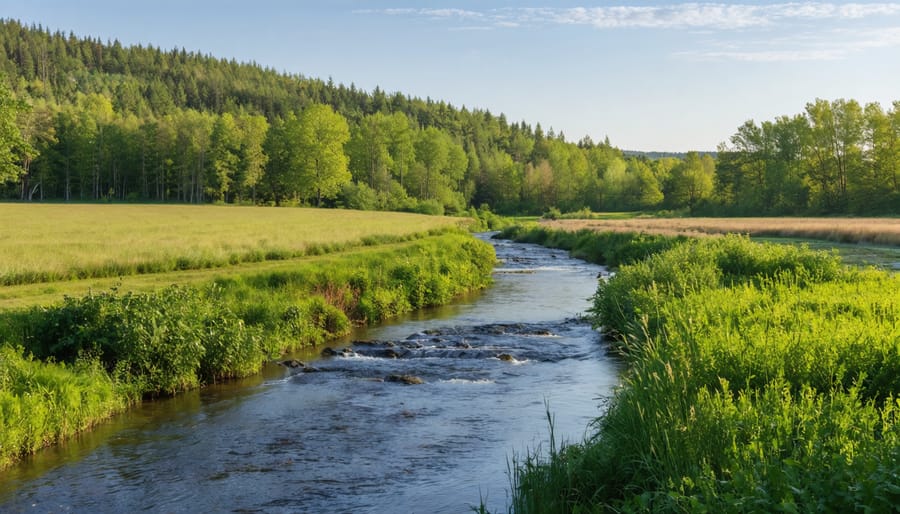Marine ecosystems hold the key to strengthening agricultural resilience along Canada’s vast coastlines. From the rich kelp forests of British Columbia to the productive salt marshes of the Maritime provinces, these dynamic underwater environments fundamentally shape our coastal farming practices. Canadian farmers harvesting alongside these marine ecosystems benefit from natural fertilization processes, enhanced soil stability, and improved water quality – advantages that translate directly to increased crop yields and sustainable farming practices.
Understanding these marine-agricultural connections has become crucial for Canadian farmers, particularly as climate change affects both ocean and land-based food production systems. The intricate relationship between seawater nutrients, coastal soil chemistry, and crop productivity demonstrates why protecting marine ecosystems isn’t just an environmental concern – it’s an agricultural imperative. By recognizing and working with these natural systems, farmers can develop more resilient and productive agricultural operations while contributing to the health of our coastal waters.
This exploration of marine ecosystems will reveal practical strategies for Canadian farmers to harness these natural relationships, backed by real-world success stories from coastal agricultural communities across the country.
Estuarine Systems Along the Canadian Coast
The Fraser River Delta System
The Fraser River Delta system in British Columbia stands as Canada’s largest estuary, covering approximately 21,000 hectares of prime agricultural land. This remarkable ecosystem, where the mighty Fraser River meets the Pacific Ocean, creates a unique environment that has supported farming for generations.
The delta’s rich sediment deposits, accumulated over thousands of years, have created some of the most fertile soil in Canada. Local farmers benefit from these nutrient-rich soils, which support diverse crops including berries, vegetables, and forage crops for livestock. The estuary’s natural water filtration system helps maintain excellent soil moisture levels, while the moderate climate influenced by marine waters extends the growing season.
What makes the Fraser Delta particularly valuable is its complex network of sloughs and wetlands that act as natural flood control systems. These waterways help protect agricultural lands during high-water events and provide crucial irrigation sources during dry periods. The delta’s ecosystem also supports vital pollinator populations and beneficial insects that contribute to crop success.
Local agricultural communities have developed innovative farming practices that work in harmony with this marine ecosystem. For example, many farmers participate in winter cover cropping programs that help protect the soil while providing habitat for migratory birds. This approach demonstrates how agricultural practices can successfully coexist with and even enhance natural marine ecosystems.
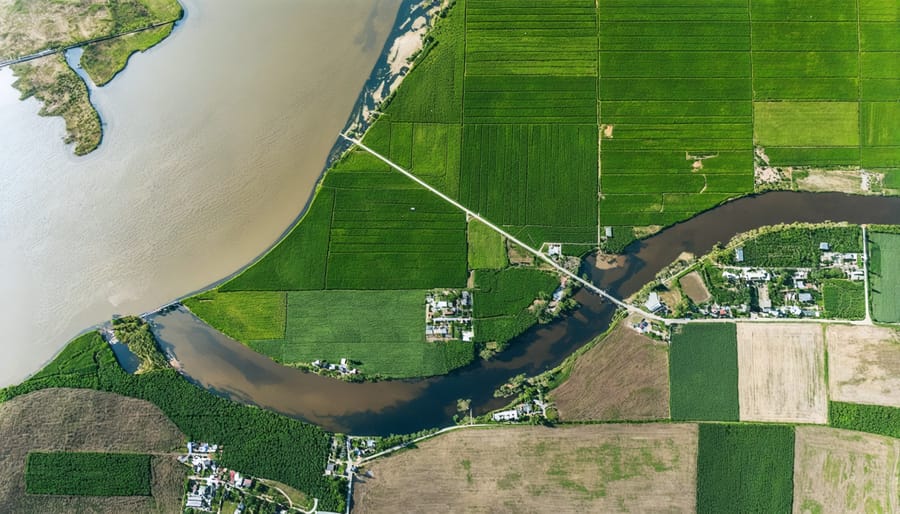
Bay of Fundy’s Tidal Influence
The Bay of Fundy’s tidal system stands as a remarkable example of how marine ecosystems can shape agricultural practices. With tides reaching up to 16 metres in height, these waters have created a unique farming landscape along Nova Scotia and New Brunswick’s coastlines.
Local farmers have historically utilized a system called dykelands, where sea walls protect reclaimed marshland from the extreme tides. These fertile soils, enriched by centuries of tidal deposits, produce exceptional yields for hay and other crops. The nutrient-rich sediment deposited during periodic flooding events continues to enhance soil fertility naturally, reducing the need for synthetic fertilizers.
Maritime farmers have developed innovative techniques to work with these tidal patterns. They time their planting and harvesting around the lunar cycles that influence tidal movements, particularly during spring and neap tides. This traditional knowledge, passed down through generations, demonstrates the deep connection between marine ecosystems and sustainable farming practices.
The dykelands also serve as natural buffers against storm surges and sea-level rise, protecting inland agricultural areas. Modern farmers are increasingly incorporating these historical techniques with contemporary sustainable practices, creating resilient agricultural systems that work in harmony with the Bay’s powerful tidal influences.
Research shows that farms utilizing these tidal-influenced soils typically require 30% less irrigation compared to conventional farmland, thanks to the natural moisture retention properties of the salt marsh-derived soil structure.
Coastal Salt Marshes

Natural Flood Protection
Salt marshes serve as nature’s first line of defense against coastal flooding, providing crucial protection for agricultural lands near marine environments. Along Canada’s coastlines, particularly in the Maritime provinces, these wetland ecosystems act as natural buffers during storm surges and extreme weather events.
When powerful waves approach the shore, salt marshes dissipate their energy through their dense network of vegetation. The marsh plants, with their strong root systems and flexible stems, work together to reduce wave height and velocity. Studies show that just 100 metres of salt marsh can reduce wave height by up to 50%, significantly decreasing the risk of flooding for inland agricultural areas.
Beyond wave absorption, these ecosystems help stabilize shorelines through sediment accumulation. Their vegetation traps and holds soil particles, gradually building up natural barriers that protect farmland from erosion. This process is particularly valuable during spring thaws when flooding risks are highest.
In Nova Scotia, farmers have reported that well-preserved salt marshes have helped prevent millions of dollars in flood damage to their fields. These natural barriers are increasingly recognized as more cost-effective and sustainable than traditional engineered flood control structures, while also supporting diverse wildlife and improving water quality.
Soil Enhancement Properties
Marsh ecosystems play a vital role in enhancing soil quality through natural processes that benefit both coastal and inland agricultural systems. These dynamic environments are powerhouses of soil nutrient cycling, converting organic matter into valuable nutrients that support plant growth.
In coastal regions of British Columbia and the Maritime provinces, salt marshes naturally filter sediments and process nutrients, creating rich deposits of organic matter. These systems can accumulate up to 5 cm of new soil annually, making them natural fertilizer factories for nearby farmland. The marsh vegetation traps minerals like nitrogen and phosphorus, while beneficial bacteria break down organic materials into forms that plants can readily use.
Studies from Nova Scotia’s Bay of Fundy region show that farms adjacent to healthy marsh systems benefit from improved soil structure and enhanced moisture retention. The marsh ecosystem’s ability to buffer pH levels also helps maintain optimal growing conditions for crops. Additionally, these systems serve as natural carbon sinks, storing approximately 40-50 tonnes of carbon per hectare annually, contributing to sustainable farming practices while supporting climate resilience in agricultural communities.

Kelp Forest Ecosystems
Natural Fertilizer Production
Kelp-based fertilizers are becoming increasingly popular among Canadian organic farmers, offering a sustainable alternative to conventional fertilizers. These marine-derived products harness the natural nutrients found in seaweed, particularly species like Ascophyllum nodosum, which thrives in North Atlantic waters. The practice aligns perfectly with the benefits of biodiversity in agricultural systems.
Recent field trials in coastal British Columbia have shown that kelp-based fertilizers can increase crop yields by 15-20% while improving soil structure and water retention. These products typically contain essential micronutrients, growth hormones, and beneficial compounds that enhance plant health and stress resistance.
For Alberta farmers, kelp-based fertilizers are available in both liquid and powder forms, making them easy to integrate into existing irrigation systems. Many producers report success using these products on various crops, from wheat and canola to market garden vegetables. The recommended application rate is typically 2-3 litres per hectare for liquid formulations, making it a cost-effective option for both small-scale and commercial operations.
Climate Resilience Benefits
Along Canada’s vast coastlines, kelp forests serve as natural barriers that protect both our shores and nearby agricultural lands from the increasingly unpredictable effects of climate change. These remarkable marine ecosystems demonstrate exceptional climate change resilience while offering multiple layers of protection for coastal farming communities.
Kelp forests act as natural breakwaters, reducing wave energy by up to 70% before it reaches the shore. This protection is particularly valuable during storm surges, helping prevent saltwater intrusion into coastal agricultural soils and reducing erosion of valuable farmland. For coastal farmers in British Columbia, these marine forests effectively shield crops from salt spray and buffer against extreme weather events.
Additionally, kelp forests help stabilize water temperatures and local weather patterns, creating more predictable conditions for nearby agricultural operations. Their extensive root systems also trap sediments, preventing coastal erosion and maintaining the integrity of shoreline farming areas. This natural infrastructure provides sustainable, long-term protection that becomes increasingly valuable as our climate continues to change.
Sustainable Management Practices
Buffer Zone Maintenance
Maintaining healthy buffer zones between agricultural land and marine ecosystems is crucial for both environmental protection and sustainable farming. These transitional areas, typically ranging from 30 to 100 metres wide, serve as natural filters that prevent excess nutrients and sediments from entering marine waters.
In coastal regions like British Columbia’s Fraser Valley, farmers have successfully implemented buffer zones using native vegetation such as Salal, Western Red Cedar, and various grass species. These plants help stabilize shorelines while providing essential wildlife habitat. Many coastal farmers have found that well-maintained buffer zones also protect their fields from salt spray and storm surge damage.
To establish an effective buffer zone, start by assessing your property’s slope and soil type. Layer your vegetation, beginning with grasses nearest to farmland, followed by shrubs, and finally larger trees closest to the water. Regular maintenance includes removing invasive species, replacing dead plants, and ensuring adequate spacing between vegetation.
For optimal results, consider implementing a three-zone approach: a grass strip for initial filtering, a managed forest area for deeper nutrient absorption, and an undisturbed natural zone along the waterline. Monitor your buffer zone seasonally, particularly after storm events, and adjust plantings as needed.
Remember that healthy buffer zones contribute to better water quality, which directly benefits marine ecosystems and, in turn, supports sustainable agricultural practices through improved irrigation water quality and enhanced pollination services from marine-dependent species.
Runoff Management
As coastal farmers, we understand the delicate balance between productive agriculture and protecting our marine ecosystems. Here in Alberta, even though we’re inland, our farming practices directly impact ocean health through our watershed systems. Managing agricultural runoff effectively is crucial for preserving marine biodiversity and ensuring sustainable farming practices.
Implementing buffer zones along waterways has proven highly successful in reducing nutrient runoff. For example, the Bow River Watershed Project demonstrated that 30-metre vegetation strips can filter up to 85% of phosphorus and nitrogen before they reach waterways. Conservation tillage practices, now adopted by over 70% of Alberta grain farmers, have significantly reduced soil erosion and chemical runoff.
Smart irrigation scheduling and soil moisture monitoring help prevent excess water application. Modern soil sensors can reduce water usage by up to 30% while maintaining crop yields. Cover crops during off-seasons not only improve soil health but also prevent nutrient leaching. Red clover and winter wheat are particularly effective choices for our climate.
Regular soil testing and precision fertilizer application ensure nutrients stay where they’re needed – in the field rather than washing into waterways. The Alberta Environmental Farm Plan program offers resources and support for implementing these practices. By working together, we’re protecting both our agricultural productivity and the marine ecosystems that ultimately connect to our farming practices through the watershed network.
Remember, every action we take on our farms contributes to the health of marine ecosystems downstream, benefiting both agricultural sustainability and marine biodiversity.
As stewards of the land, we share a vital connection with our coastal environments, even here in Alberta. The health of marine ecosystems directly impacts our agricultural success through complex relationships that span weather patterns, soil health, and food security. These marine systems provide essential nutrients, regulate climate patterns that affect our growing seasons, and support the biodiversity that keeps our agricultural systems resilient.
By protecting marine ecosystems, we safeguard crucial resources like fish-based fertilizers and seaweed products that many Canadian farmers rely on for sustainable soil management. The marine food web also supports migratory birds that help control pest populations in our fields, demonstrating how distant ecosystems influence our day-to-day farming practices.
Looking ahead, our commitment to marine conservation strengthens food security for future generations. When we support initiatives to protect coral reefs, mangroves, and coastal wetlands, we’re investing in natural systems that buffer against extreme weather events and maintain the delicate balance that agriculture depends on.
As a farming community, we can take practical steps by choosing sustainably sourced marine-based products, supporting ocean-friendly policies, and sharing knowledge about these crucial connections with fellow farmers. Remember, healthy oceans mean healthy farms – and together, we can ensure both continue to thrive for generations to come.

